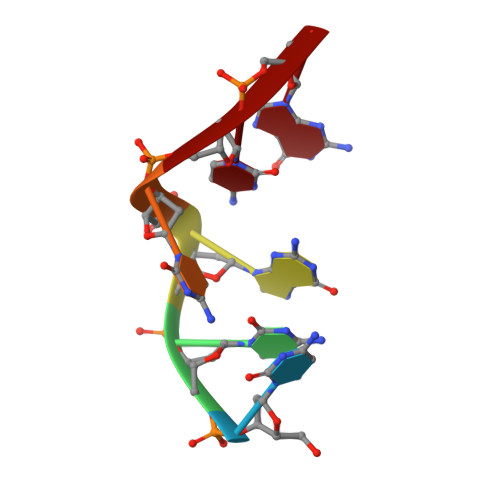Genetically unstable CXG repeats are structurally dynamic and have a high propensity for folding. An NMR and UV spectroscopic study.
Zheng, M., Huang, X., Smith, G.K., Yang, X., Gao, X.(1996) J Mol Biol 264: 323-336
- PubMed: 8951379
- DOI: https://doi.org/10.1006/jmbi.1996.0643
- Primary Citation of Related Structures:
1NOQ - PubMed Abstract:
Recent molecular genetics studies have revealed a correlation between spontaneous, progressive expansion of several DNA trinucleotide repeats and certain hereditary neurodegenerative diseases. Triplet repeat (TR) sequences may be present in structured forms that can mediate the processes interrupting normal cellular replication, transcription, or repair activities, eventually leading to gene mutation. Using high resolution NMR spectroscopy and other biophysical methods, we probed the solution structures and properties of single-stranded TR sequences. These studies have led to the discovery of a new duplex motif (e-motif), present in CCG repeats, and to the elucidation of the structure of the (CTG)3 duplex. In this paper we provide a global picture of the solution behavior of the human disease-related CXG (X = A, C, G, or T) and the comparison GXC (X = A, or T) TR sequences. All six triplet repeats form antiparallel duplexes. The mismatched bases in CAG and CGG repeat duplexes are rather flexible and they do not appear to form stable, paired conformations. By comparison, GAC repeat duplexes and their mismatched A residues are well-structured. Most interestingly, the structures of the disease-related CXG repeats exhibit a propensity for folding at chain lengths as short as 12 residues. Furthermore, the energy barrier for the formation of homo-duplexes from the corresponding complementary hetero-duplexes are much lower for the CXG TR sequences than for the GAC or GTC TR sequences. These results provide insights into the conformation and physiochemical properties of TR sequences. Thus, a basis is provided for further studies of the behavior of long TR sequences in an effort to elucidate the molecular mechanisms of in vivo expansion and function of TR sequences.
Organizational Affiliation:
Department of Chemistry, University of Houston, TX 77204-5641, USA.














